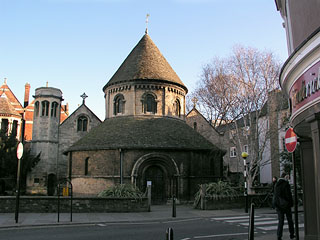 |
Only four round churches now survive in England. They are the Temple Church in London, Little Maplestead in Essex, St Sepulchre's in Northampton and Holy Sepulchre here in Cambridge. [Mark adds: although he's left out the Round Chapel of Ludlow Castle I think Ben must mean mediaeval round churches, for example, in my own home town of Shrewsbury the georgian rebuild of St Chad is a huge, and very elegant, round church - not that this excuses the monstrous vandalism (involving Thomas Telford, tight-fisted churchwardens, hapless Irish Navvies and a mistimed lunch-break) that lead to the need for the rebuilding - but that's another story...]
The popular mythology is that all round churches belonged to the Templars. This isn't true - Little Maplestead, for example, was owned by the Knights Hospitaller. Both the Templars and the Hospitallers had strong links with Palestine, of course, and the usual explanation for the shape of these churches is that they were built in imitation of the Church of the Holy Sepulchre in Jerusalem. This gives us a bit of a puzzle in Cambridge, though. The Round Church here was founded by a 'Confraternity of the Holy Sepulchre', who were given the land by Abbot Reinald of Ramsey between 1114 and 1130. This aside, nothing is known about the Confraternity. Some sort of Jerusalem connection seems likely, given the date and the dedication, but this is inevitably speculation.
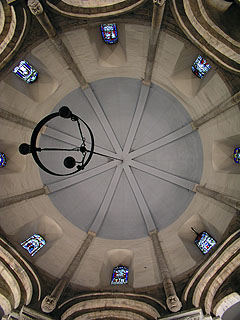 |
The church was built around 1130. It started its life as a wayfarers' chapel but soon became a parish church serviced by the Austin Friars from the nearby Hospital of St John (which later became St John's College). It is now no longer an active parish church, but it's open most of the time, and houses a rather nice exhibition about the history of the church and of Cambridge Christianity more generally.
The building has been more battered by the centuries than most of Cambridge's churches. It sits at the northern end of the shopping precinct, guarding the junction between Bridge Street, St John's Street, Sidney Street and Round Church Street. Behind it lies the Union Building, the gloomy red brick Victorian home of the university debating society for the rich and pompous. From the outside, Holy Sepulchre looks rather the same - gloomy and Victorian that is, not rich and pompous. The stonework is grimy, and the pointed hat on the clerestory looks faintly ridiculous.
As it happens, the impression is both right and wrong. Right, because much of the church was rebuilt in the 1840s, when the Camden Society were brought in after part of the ambulatory vaulting had collapsed. Wrong, because the restoration is generally felt to have been a model of authenticity. I'm undecided as to exactly what I think about it. As was often the case with the Camden Society, they looked back in time and chose a 'golden age' to which they returned the church. This meant, for example, destroying the tall belfry that had been put on top of the nave in the 15th century, and replacing it with an 'authentic' Norman-style clerestory and dome. I've seen pictures of the belfry and it looks like it was rather nice - but the present structure is also good, and one cannot deny that the Confraternity of the 12th century would better recognise the church today than they would have done 200 years ago.
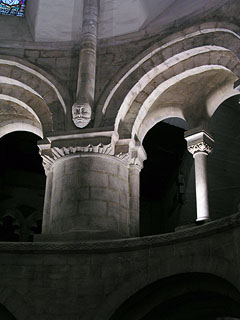 |
Moving inside, the feeling of age increases enormously. Here, ancient work and 19th century restoration blend together effortlessly, and the effect is very beautiful. Eight solid pillars hold up the central lantern. The pillars are great fat things, with a variety of Norman decorations on the capitals. Then there rises a little triforium, with very delicate pillars in the middle of two-light openings. Above that the 19th century clerestory rises. Big heads in the triforium level support engaged shafts which rise between the clerestory windows, and these support a ribbed dome painted in pale sky blue. The ambulatory has fine vaulting - most of it is rebuilt, but save for a little on the east side which was destroyed in an 1841 collapse it is the original stonework that has been re-erected. The windows in the ambulatory and the clerestory contain wonderful glass. They were by Thomas Willement and inserted during the restoration, although some of them are made from reassembled medieval fragments. They're all very nice, though - the colours are bright, and the style is much more faithful to medieval examples than in most Victorian glass. Many are copies of windows existing elsewhere - there is an image of Adam taken from Canterbury Cathedral, for example. On a sunny day, the windows glow like jewels.
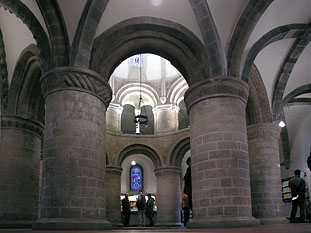 |
The round part of the church is only the nave, of course. The first extension eastwards was made in the 13th century, but the latest work that survives is in the north chapel, and that is 15th century. The chancel and south aisle were completely rebuilt, and by comparison with the nave they are horribly bland. The angel roof in the north chapel is quite nice, although the wood is very dark, and the light is very bad - on this side, the church is quite hemmed in by surrounding buildings - so it's difficult to make out any details. Supposedly, the angels are 15th century, but I find this surprising. Dowsing records his visit here on the 2nd of January 1644. It seems unlikely that the angels would have survived unscathed given how comparatively low they are, but even more peculiarly, he doesn't record them - he mentions
"14 superstitious pictures, and diverse idolatrous inscriptions, and one of God the Father, and of Christ, and of the Apostles"
but nothing else. Given how enthusiastically he instructed people to destroy angel roofs elsewhere, I can only speculate that the angels were hidden, or gone. Still, they are back now, and they certainly don't look too Victorian.
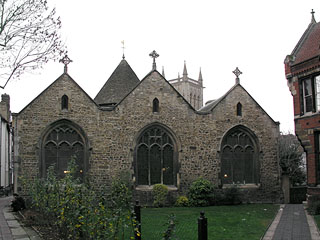 |
I'm not so sure that it matters, really. Here, at least, we have a lot for which to thank the Camden Society - had they not intervened in the 1840s, it is likely that the whole church would have collapsed, and not just part of the ambulatory. I regret the loss of the 15th century belfry, though. Part of the joy of church-spotting is that these buildings were continually extended, rebuilt and 'improved' as the centuries passed, and returning the building to its original state loses us some of that richness. Of course, one might say that the 19th century restoration is just another part of this story - and that would be right. But isn't there a difference between a self-consciously backward looking restoration and the sort of fashionable innovation that gave us the chapel at King's College, or the church at Burwell? Maybe even Holy Sepulchre seemed strikingly modern in its day.
The Church of the Holy Sepulchre is open to visitors on most days.